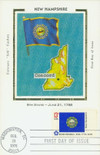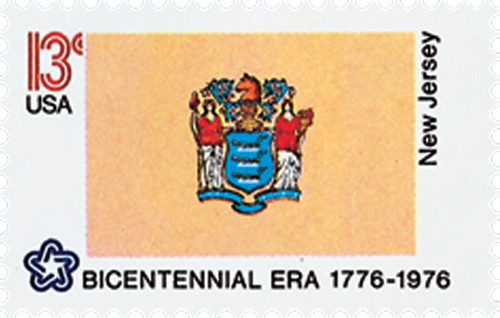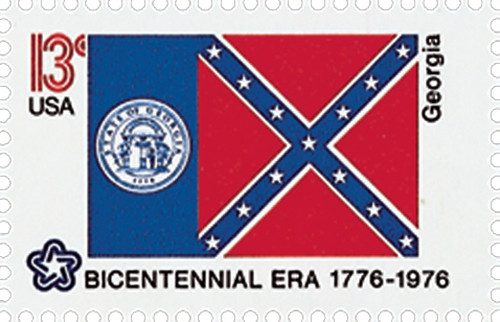
# 1641 - 1976 13c State Flags: New Hampshire
U.S. 1641
1976 New Hampshire State Flag
State Flags
American Bicentennial Series
• First time a sheet 50 had all different stamp designs
• Part of the American Bicentennial Series
Stamp Category: Commemorative
Series: American Bicentennial Series
Value: 13¢ First-class postage rate
First Day of Issue: February 23, 1976
First Day City(s): Washington, DC
Quantity Issued: 8,720,100 (panes of 50)
Printed by: Bureau of Engraving and Printing
Printing Method: Photogravure
Format: Sheet of 50
Perforations: 11
Why the stamp was issued:
The United States Postal Service celebrated the American Bicentennial with a full pane of the Union’s fifty state flags.
About the stamp design:
New Hampshire’s blue state flag is made up of the State Seal, which is located in the center. The New Hampshire legislature voted in 1784 to make the Raleigh and the shipyard on the island the focus of its state seal. Surrounding the seal is a wreath of laurel leaves and nine stars interspersed show they were the 9th state to join the Union.
About the printing process: Printed by the Bureau of Engraving and Printing on their seven-color Andreotti gravure press (601) which was their work horse for multicolored stamps.
About the American Bicentennial Series:
In the 1970s, America celebrated its 200th anniversary with hundreds of national events commemorating the heroes and historic events that led to our nation’s independence from Great Britain. The U.S. Postal Service issued 113 commemorative stamps over a six-year period in honor of the U.S. bicentennial, beginning with the American Revolution Bicentennial Commission Emblem stamp (U.S. #1432). As a group, the Bicentennial Series chronicles one of our nation’s most important chapters, and remembers the events and patriots who made the U.S. a world model for liberty.
Several of the stamps honored colonial life – craftsmen and communication. Other stamps honored important battles including Lexington and Concord, Bunker Hill, and Saratoga. Significant events such as the Boston Tea Party, the meeting of the First Continental Congress, and the Declaration of Independence were featured as well. The stamps also honored many significant people such as George Washington, Sybil Ludington, Salem Poor, and the Marquis de Lafayette.
Many of the stamps feature classic artwork. For instance, the set of four souvenir sheets picture important events recreated by noted artists such as John Trumbull. The Bicentennial Series also includes an important US postal first – the first 50-stamp se-tenant – featuring all 50 state flags. The format proved to be popular with collectors, and has been repeated many times since.
The American Bicentennial Series is packed with important US history – it tells the story of our nation’s fight for independence through stamps.
History the stamp represents:
On June 21, 1788, New Hampshire ratified the U.S. Constitution and was admitted to the Union.
What is now New Hampshire was home to about 5,000 American Indians before European settlement. Most of these people belonged to the Algonquian Indian family. These Native Americans built houses called wigwams out of bark and animal skins. Hunting and fishing were supplemented by small-scale farming of corn. The Algonquian Indians often fought with their neighbors, the Iroquois.
It is unknown which European explorer first reached today’s New Hampshire. But, by the early 1600s, many expeditions had set foot on this land. In 1603, Martin Pring, an Englishman, sailed a trading ship up the Piscataqua River. Pring may have landed at the site of present-day Portsmouth. In 1605, the French explorer Samuel de Champlain landed on the New Hampshire coast. The English captain John Smith reached the Isles of Shoals in 1614.
King James I of England was very interested in settling the New England area. In 1619, he founded the Council for New England to organize and encourage settlers. The council gave David Thomson control of a large chunk of land in the New Hampshire area. Thomson settled in Odiorne’s Point, which is now part of Rye, in 1623. Edward Hilton established another settlement in the 1620s. Hilton’s group settled Hilton’s Point, which is now called Dover. Other early settlements include Stawbery Banke at the site of present-day Portsmouth in 1630, and Exeter and Hampton in 1638.
The famous patriot leader Paul Revere rode to New Hampshire in December of 1774 to warn of an increase in British troops in the area. This prompted New Hampshire patriots under the leadership of John Sullivan to seize arms from a British military fort in New Castle. This raid was one of the first Colonial military actions against the British.
When the War for Independence broke out in Massachusetts in 1775, New Hampshire responded by sending hundreds of “minutemen.” New Hampshire’s soldiers served with distinction. Interestingly, New Hampshire was the only colony of the original 13 in which no actual fighting took place.
New Hampshire was the first colony to form its own independent government. On January 5, 1776, it adopted a temporary constitution. On June 21, 1788, New Hampshire became the ninth state to ratify the United States Constitution. New Hampshire’s approval of the document put the Constitution into effect and officially made it the United States of America’s ninth state.
U.S. 1641
1976 New Hampshire State Flag
State Flags
American Bicentennial Series
• First time a sheet 50 had all different stamp designs
• Part of the American Bicentennial Series
Stamp Category: Commemorative
Series: American Bicentennial Series
Value: 13¢ First-class postage rate
First Day of Issue: February 23, 1976
First Day City(s): Washington, DC
Quantity Issued: 8,720,100 (panes of 50)
Printed by: Bureau of Engraving and Printing
Printing Method: Photogravure
Format: Sheet of 50
Perforations: 11
Why the stamp was issued:
The United States Postal Service celebrated the American Bicentennial with a full pane of the Union’s fifty state flags.
About the stamp design:
New Hampshire’s blue state flag is made up of the State Seal, which is located in the center. The New Hampshire legislature voted in 1784 to make the Raleigh and the shipyard on the island the focus of its state seal. Surrounding the seal is a wreath of laurel leaves and nine stars interspersed show they were the 9th state to join the Union.
About the printing process: Printed by the Bureau of Engraving and Printing on their seven-color Andreotti gravure press (601) which was their work horse for multicolored stamps.
About the American Bicentennial Series:
In the 1970s, America celebrated its 200th anniversary with hundreds of national events commemorating the heroes and historic events that led to our nation’s independence from Great Britain. The U.S. Postal Service issued 113 commemorative stamps over a six-year period in honor of the U.S. bicentennial, beginning with the American Revolution Bicentennial Commission Emblem stamp (U.S. #1432). As a group, the Bicentennial Series chronicles one of our nation’s most important chapters, and remembers the events and patriots who made the U.S. a world model for liberty.
Several of the stamps honored colonial life – craftsmen and communication. Other stamps honored important battles including Lexington and Concord, Bunker Hill, and Saratoga. Significant events such as the Boston Tea Party, the meeting of the First Continental Congress, and the Declaration of Independence were featured as well. The stamps also honored many significant people such as George Washington, Sybil Ludington, Salem Poor, and the Marquis de Lafayette.
Many of the stamps feature classic artwork. For instance, the set of four souvenir sheets picture important events recreated by noted artists such as John Trumbull. The Bicentennial Series also includes an important US postal first – the first 50-stamp se-tenant – featuring all 50 state flags. The format proved to be popular with collectors, and has been repeated many times since.
The American Bicentennial Series is packed with important US history – it tells the story of our nation’s fight for independence through stamps.
History the stamp represents:
On June 21, 1788, New Hampshire ratified the U.S. Constitution and was admitted to the Union.
What is now New Hampshire was home to about 5,000 American Indians before European settlement. Most of these people belonged to the Algonquian Indian family. These Native Americans built houses called wigwams out of bark and animal skins. Hunting and fishing were supplemented by small-scale farming of corn. The Algonquian Indians often fought with their neighbors, the Iroquois.
It is unknown which European explorer first reached today’s New Hampshire. But, by the early 1600s, many expeditions had set foot on this land. In 1603, Martin Pring, an Englishman, sailed a trading ship up the Piscataqua River. Pring may have landed at the site of present-day Portsmouth. In 1605, the French explorer Samuel de Champlain landed on the New Hampshire coast. The English captain John Smith reached the Isles of Shoals in 1614.
King James I of England was very interested in settling the New England area. In 1619, he founded the Council for New England to organize and encourage settlers. The council gave David Thomson control of a large chunk of land in the New Hampshire area. Thomson settled in Odiorne’s Point, which is now part of Rye, in 1623. Edward Hilton established another settlement in the 1620s. Hilton’s group settled Hilton’s Point, which is now called Dover. Other early settlements include Stawbery Banke at the site of present-day Portsmouth in 1630, and Exeter and Hampton in 1638.
The famous patriot leader Paul Revere rode to New Hampshire in December of 1774 to warn of an increase in British troops in the area. This prompted New Hampshire patriots under the leadership of John Sullivan to seize arms from a British military fort in New Castle. This raid was one of the first Colonial military actions against the British.
When the War for Independence broke out in Massachusetts in 1775, New Hampshire responded by sending hundreds of “minutemen.” New Hampshire’s soldiers served with distinction. Interestingly, New Hampshire was the only colony of the original 13 in which no actual fighting took place.
New Hampshire was the first colony to form its own independent government. On January 5, 1776, it adopted a temporary constitution. On June 21, 1788, New Hampshire became the ninth state to ratify the United States Constitution. New Hampshire’s approval of the document put the Constitution into effect and officially made it the United States of America’s ninth state.


















